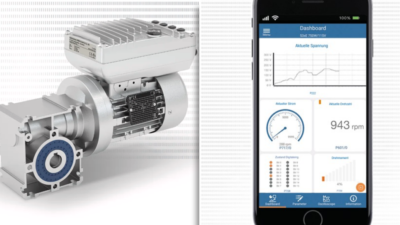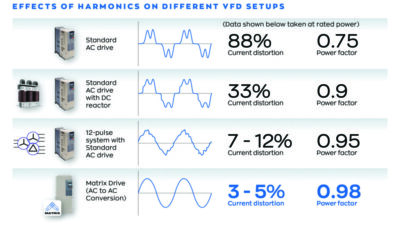Dealing with constraints is part of the daily routine at Phoenix-based On Semiconductor. Whether it involves creating demand scenarios or determining supply levels, numerous factors must be considered when moving goods down the supply chain. “During forecasting, we try to have the right amount of capacity, and also stage the right level of inventory,” says Ravi Vancheeswaran, dir...
Dealing with constraints is part of the daily routine at Phoenix-based On Semiconductor . Whether it involves creating demand scenarios or determining supply levels, numerous factors must be considered when moving goods down the supply chain.
“During forecasting, we try to have the right amount of capacity, and also stage the right level of inventory,” says Ravi Vancheeswaran, director of global customer service operations. “We create different demand scenarios to see the impact of constraints on supply. If we squeeze the back end, we starve the front end. So we must determine the right capacity to invest in across our 20 entities in the supply chain.”
| Companies that enact integrated business planning (IBP) processes reportedly achieve higher return on net assets (RONA) while simultaneously accelerating their cash-to-conversion cycles. |
Earlier this year, On Semiconductor implemented a closed-loop sales and operations planning (S&OP) process to determine how to properly allocate its capacity.
“Three turning gears—revenue, inventory, and factory utilization—must be in sync to ensure our S&OP process is aligned,” says Vancheeswaran. “Our goal is to maximize revenue and margins, while keeping inventory as low as possible—but not compromise on-time delivery and good customer service.”
Traditional S&OP is a cross-functional planning process that sets the overall level of manufacturing output to best satisfy the current planned levels of sales, while meeting general business objectives of profitability and productivity. However, in many cases, companies have found the data they collected to be both inaccurate and untimely, causing plants to produce the wrong mix of products and scrambling to meet actual customer demand.
Globalization, demand uncertainty, and rising supply chain costs necessitate enhancing the S&OP process to prevent some of its common pitfalls. For some that means improving forecast accuracy by facilitating collaboration between sales and operations, solving the apparent misalignment and disconnects between the two groups. Still others believe adding flexibility into S&OP and implementing real-time demand and supply balancing will allow companies to quickly alter production and supply chain strategies.
Forward-thinking companies such as On Semiconductor have adopted closed-loop S&OP scenarios that tighten the gaps in forecasting and demand planning and directly link revenue to strategic business goals.
The $2-billion company uses a multi-stage inventory planner from i2 Technologies for its three-stage production process. It begins with a wafer or substrate stage; then features and functions are added during the fabrication process; and then the die stage marks it as finished goods.
“Our inventory value goes up as we move down the supply chain,” says Vancheeswaran. “We want to hold less at the die stage and more at the substrate level. However, if we move products further down the supply chain to better serve customers, it will cost us in inventory.”
Vancheeswaran says the difficulty of supply and demand balancing is determining the right product mix and reconciling the build plan with the revenue plan.
“We build a little more into the forecast because we know it will not be as accurate as we want. By limiting the build plan, we are truly doing S&OP,” says Vancheeswaran.
Redefined and enhanced
Some companies say their method of balancing supply with demand is so different from traditional S&OP that it deserves a different name: integrated business planning, or IBP. Those familiar with IBP say it involves extensive cross-functional collaboration and allows for financial modeling, scenario planning, reporting, and analytics.
| Integrated business planning (IBP) differs from sales & operations planning (S&OP) in that it involves more collaboration between the various roles of the organization to unify business goals and strategies rather than functioning as a strict supply chain process. |
Boston-based Aberdeen Research recently published a report on IBP, taking a closer look at the key business strategies companies adopted in 2008. Author Nari Viswanathan discovered deeply embedded organizational and structural missteps that contribute to eventual S&OP failures.
“I was surprised by the misalignment between S&OP and general business goals,” says Viswanathan. “Typically, both sales and operations still are considered in their individual silos, and that mind-set triggers a lack of collaboration between players. This disconnect has contributed to the demise of many S&OP initiatives.”
In many companies, yearly budgets are set with good intentions of following corporate goals, but without feedback between finance and operations, business strategies are quickly forgotten or revised without consent from both parties.
“Finance managers typically look at supply chain as a back-end function and supply chain workers don’t always understand finance,” says Viswanathan. “One solution is to employ a manager who talks both languages to bridge the gap between the groups.”
Mihir Wagle, a senior consultant from River Logic , a supply chain planning software supplier, says many organizations tend to be shortsighted when it comes to painting an accurate supply-and-demand picture.
“Supply managers measure throughput,” says Wagle, “but they don’t realize how their decisions can affect financials or general business goals.” Traditional S&OP falls short, Wagle adds, because it only considers historical data and does not look at changes in the marketplace or current trends.
“With IBP, users run different models and scenarios across a business using constraint-based reasoning to determine if working capital should be adjusted,” explains Wagle. “This process is difficult if you are using a series of connected spreadsheets because the model must be rebuilt every time a change is made.”
River Logic’s Enterprise Optimizer is a decision-support platform that uses advanced planning and available-to-promise data to develop a graphical representation of a business plan. The system looks at who has available capacity or flex capacity and asks questions such as: What percentage will we lose if we take this order? Will storage capacity be freed up?
Yet companies typically consider critical parts first when allocating capacity, but sometimes forget smaller, noncritical components.
“An airplane manufacturer could have everything assembled, but have to wait for small fasteners or connectors,” says John Bermudez, a VP in the supply chain group of enterprise software giant Oracle . “We have the technology today to explode a bill of material down to even the smallest, uncommon parts.”
A module within Oracle’s promotion management system rectifies a problem that routinely renders S&OP ineffective: that of inaccurate data on actual sales. The module allows salespeople to track their performance against sales quotas every day, and it lists running tally of their commissions. The only catch is these numbers—including the totals on sales commissions—will not be accurate if the salesperson does not enter updated data regularly.
Accuracy front and center
Since the S&OP process begins with a forecast, many believe the focus should be on improving up-front accuracy. Giving sales and operations more flexibility is one answer to fostering collaboration between the two groups.
“Many companies are moving away from tightly coupled S&OP,” says Kim Orumchian of Right90 , a vendor of sales forecasting software. “If both groups lose flexibility, sales cannot sell creatively and they lose their ability to compete.”
Eliciting a timely response from sales also is very important, but it can be hampered by reliance on multiple spreadsheets.
“It can be difficult to get salespeople to use the same system since many are comfortable using their own methods and tools,” says Orumchian. “If 300 salespeople all send in reports in various formats, it takes a great deal of time to reconcile the data.”
Another step in the S&OP process is added if a company wants to compare actuals with historical data, although today’s market uncertainty can make trends irrelevant. When oil prices are flat, logistics costs are low, but energy volatility can put a premium on longer-range demand.
“There might be strong demand overseas, but certain countries bring lower price points,” says Orumchian.
Evergreen Solar , a maker of solar panels, tries to remain flexible during forecasting for its team of eight salespeople. The Marlboro, Mass.-based company sets a five-year forecast using Right90’s software, but updates its weekly forecast on a real-time basis.
“The sales staff updates pricing, volume, and new opportunities whenever they occur,” says Alex Keally, sales planning and analysis manager. “If they notice a discrepancy, they can drill down to see changes in price, product, or regional mix.”
Operating with little inventory, Evergreen Solar functions similar to a semiconductor supplier since the supply of its high-tech products’ fluctuates widely according to demand.
“Solar panels are sold by wattage in varying efficiencies, so we don’t really know the finished product until it is actually made,” says Keally. “Our forecast will show all the products that will be available in a certain quarter and we can then decide which customers will get the most efficient products.”
Evergreen Solar put in the Right90 system almost a year ago to update the spreadsheets it had been using. Managers knew that if they added another level of detail to their spreadsheets, they would be too cumbersome to use.
“We wanted to look at more financial facets of our business, such as working capital needs and cash flow by currency,” explains Keally.
Since most companies realize total forecast accuracy is an elusive goal, many try to offset the failures by quickly adjusting to changing demand. Collaboration and risk mitigation are two important strategies that can make companies more adroit in altering production and supply chain strategies on-the-fly.
“Our position is rapid response,” says Trevor Miles, a company director for supply chain software vendor Kinaxis . “It’s inevitable that customers will not buy what we think they will, so we have to be prepared to scramble to meet reality.”
Side-by-side views
An integrated business plan that includes balanced scorecards allows users to tie financials to operational metrics such as cost of goods sold. Also, systems can compare scenarios side-by-side to see where plans must be altered.
“If a company allocates 30 percent of its demand to one customer and the plant can’t deliver, it must decide which customer will be shorted and how it will affect additional supply,” says Miles.
If companies are forced to stop production or change distribution routes to reallocate orders, users should remember to consider the financial impact these decisions can make.
“If orders are cancelled, are there any penalties incurred?” asks Miles. “A company may have to turn to a secondary supplier to get special material, and that extra cost likely was not planned.”
Inconsistent demand signals and long lead times are two challenges Bedoukian Research is accustomed to in running its specialty fragrances and flavors business. The Danbury, Conn.-based chemical company deals with both raw material and finished goods inventory, stocking nearly 400 products used to make artificial fragrances for food, laundry soap, perfumes, and shampoo. Only 80 products make up the bulk of the company’s stock, so it focuses on optimizing forecasts with this group.
“We try to have our major products in stock because not all of our customers place orders far in advance,” says Leona Eggleston, purchasing manager. “We are left to guess what they want, and if we don’t have it, they will look elsewhere for it.”
Many of the fragrances are made from exotic materials sourced from overseas. Raw materials forecasts are particularly difficult since orders consist of batches that are used for multiple items. Bedoukian manages the forecasting process with an application from Smart Software that integrates with Bedoukian’s ERP system.
Production time is about two weeks once all the materials are in stock. Eggleston also has implemented a reorder process that sets order points within the system to prevent stock-outs.
“We can see in our weekly reports if we fall below the threshold in raw materials, she says. “Then we look at the forecast and historical data to see if the numbers are skewed.”
Electric avenue: Zero Motorcycles revs up S&OP with SaaS-ready BI
Zero Motorcycles is all about what’s changing—from its patented battery technology, electric bike design, and lightweight materials to its hybrid direct sales/independent reps go-to-market strategy. And just like its high-performance bikes, the two-year-old company is racing to add to the product line to extend market reach in 2009.
It’s a goal that touches nearly every aspect of the business.
To succeed, says John Lloyd, VP of sales for the Santa Cruz, Calif.-based company, a dynamic business intelligence (BI) solution is coming into play to rapidly adapt to the demands of everyone in sales & marketing, as well as engineering and manufacturing.
“We design, manufacture, and deliver 100-percent electric motorcycles,” Lloyd states. “We shipped 200 units in 2008, and expect to ship 1,500 to 2,000 in 2009. We are preparing to scale massively in North America and Europe. If you look at our business model, it’s critical that we be just-in-time with data in terms of sales & operations planning and predictability so we don’t over-buy inventory or under-deliver on product. To do this, we must know past, present, and future trends—and get that information quickly to marketing and manufacturing, and even engineering.”
Zero Motorcycles is using Cloud9 Analytics, a BI tool and intelligent data warehouse that takes advantage of the benefits of cloud computing in a Software-as-a-Service (SaaS) model.
“We recognized right away the need for a tool to augment our Salesforce.com CRM systems,” Lloyd says. “The challenge was managing the process between the book date and the ship date, and then knowing what changed in between. Cloud9 makes it easy for us to take a snapshot and present it in one lens.”
Cloud9 is distinctive among BI solutions in delivering an intelligent data warehouse in the cloud.
“One of the challenges of tracking the performance of your sales organization is in knowing what’s changed,” says Rob Bois, a director with Boston-based AMR Research. “IT has to be heavily involved in that process to [deliver] the right information. In-house BI tools typically are very IT-heavy, especially if users want to tweak or customize the data structure.”
Intelligence within the Cloud9 data warehouse cuts the complexity by automatically monitoring changes in data structures and accommodating user requests for changes.
“BI is more of a data-management problem than a tools issue,” says Swayne Hill, CEO, Cloud9. “Our goal is to bring the best of BI as it’s traditionally known, but without the cost and complexity. We eliminated a lot of the complexity by solving a number of interesting data-management problems.”
For example, CRM solutions show only a current status view.
“We’re able to take a nightly snapshot of Salesforce.com data and accumulate a history of what’s changed,” says Hill. “That gives our customers leading indicators about their businesses so they can respond, focusing on what’s most important.”
As Cloud9’s Lloyd points concludes, “Marketing is always eager to know what is selling, and engineering wants to know what else they can add to attract more customers.” Cloud9, he explains, has proven ready and able to easily answer the tough questions about what’s changed—and do it as quickly as the questions change.
—Frank O Smith, senior contributing editor ([email protected])



